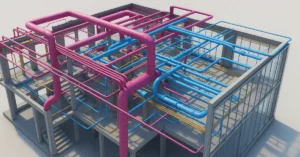Unlocking the Full Potential of BIM in Germany’s Modern Construction
Germany, known for its engineering excellence and technological innovation, is at the forefront of adopting cutting-edge solutions in various industries. One of the most significant advancements in recent years is the adoption of Building Information Modeling (BIM) in the construction sector. As Germany continues to modernize its infrastructure and enhance its construction processes, BIM is set to play a pivotal role. This article explores how BIM is shaping the future of construction in Germany, offering insights into its benefits, challenges, and transformative impact on the industry.
Understanding BIM
Building Information Modeling (BIM) is a digital process that involves the generation and management of digital representations of physical and functional characteristics of places. BIM goes beyond simple 3D modeling, incorporating data that can be used throughout the lifecycle of a construction project—from design and construction to operation and maintenance. This holistic approach ensures that all stakeholders have access to consistent and accurate information, facilitating better decision-making and collaboration.
The Importance of BIM in Modern Construction
The construction industry is notoriously complex, involving numerous stakeholders, intricate processes, and significant investments. Traditional methods often lead to inefficiencies, errors, and delays. BIM addresses these issues by providing a unified platform where architects, engineers, contractors, and owners can collaborate effectively. The benefits of BIM in modern construction include improved design accuracy, enhanced project visualization, better cost control, and more efficient project management.
BIM in Germany: Current State and Adoption
Germany has been gradually adopting BIM over the past decade, recognizing its potential to revolutionize the construction industry. The German government has been proactive in promoting BIM adoption through various initiatives and regulations. In 2015, the German Federal Ministry of Transport and Digital Infrastructure (BMVI) launched the “Digital Construction” initiative, which mandates the use of BIM for all public infrastructure projects by 2020. This policy shift has been instrumental in driving BIM adoption across the country.
Key Drivers of BIM Adoption in Germany
Government Initiatives and Regulations
The German government’s commitment to digital transformation in construction is a significant driver of BIM adoption. The “Digital Construction” initiative, along with the establishment of the National BIM Competence Center, provides a structured framework for BIM implementation. These efforts aim to standardize BIM practices, develop guidelines, and offer training programs to ensure a smooth transition for the industry.
Technological Advancements
Germany’s strong technological foundation supports the adoption of BIM. The integration of BIM with other emerging technologies, such as the Internet of Things (IoT), artificial intelligence (AI), and advanced data analytics, is enhancing the capabilities of BIM platforms. These technologies enable real-time data collection and analysis, predictive maintenance, and automated decision-making, further driving the adoption of BIM in the construction sector.
Industry Collaboration
Collaboration among industry stakeholders is crucial for successful BIM implementation. In Germany, various industry associations, such as buildingSMART Germany, play a vital role in promoting BIM standards and best practices. These associations facilitate knowledge sharing, training, and networking opportunities, fostering a collaborative environment for BIM adoption.
Benefits of BIM in German Construction
Enhanced Design and Visualization
BIM enables the creation of detailed 3D models that provide a comprehensive view of the project. This enhanced visualization helps stakeholders understand the design intent, identify potential issues, and make informed decisions early in the project lifecycle. In Germany, this capability has been particularly beneficial for complex infrastructure projects, such as the Stuttgart 21 railway project, where BIM was used to manage intricate design elements and ensure accurate construction.
Improved Collaboration and Communication
One of the most significant advantages of BIM is its ability to facilitate collaboration among different stakeholders. In traditional construction projects, miscommunication and lack of coordination often lead to errors and delays. BIM’s centralized platform allows for real-time information sharing, ensuring that all parties have access to the latest project data. This improved communication streamlines workflows, reduces errors, and enhances overall project efficiency.
Cost and Time Savings
BIM helps in identifying potential issues and clashes early in the design phase, reducing the likelihood of costly rework during construction. The ability to simulate construction processes and optimize resource allocation leads to significant cost and time savings. In Germany, the use of BIM in the construction of the Berlin Brandenburg Airport helped in identifying and resolving design conflicts, resulting in smoother construction and reduced delays.
Sustainability and Energy Efficiency
Sustainability is a key focus in Germany’s construction industry. BIM supports sustainable design and construction practices by enabling energy performance analysis, material optimization, and environmental impact assessments. For example, in the construction of the new European Central Bank headquarters in Frankfurt, BIM was used to model energy-efficient systems and materials, contributing to the building’s high sustainability standards.
Lifecycle Management
BIM’s capabilities extend beyond the construction phase, providing valuable tools for the operation and maintenance of buildings and infrastructure. The digital models created during the design and construction phases serve as a comprehensive information source for facility management. This lifecycle approach ensures that buildings are maintained efficiently, reducing operational costs and extending the lifespan of assets.
Challenges in BIM Adoption in Germany
While the benefits of BIM are substantial, its adoption in Germany faces several challenges:
Lack of Standardization
Despite efforts to develop national BIM standards, there is still a lack of uniformity in BIM practices across the industry. This inconsistency can lead to difficulties in collaboration and information exchange. Establishing and enforcing standardized BIM protocols is essential for maximizing the benefits of BIM.
Training and Education
The successful implementation of BIM requires a workforce with the necessary skills and knowledge. There is a need for comprehensive training and education programs to equip professionals with BIM expertise. In Germany, various educational institutions and industry associations are working to address this need, but more efforts are required to ensure widespread BIM proficiency.
Initial Investment
The transition to BIM involves significant upfront investment in software, hardware, and training. While the long-term benefits outweigh the initial costs, this investment can be a barrier for smaller firms and public sector organizations with limited budgets. Financial support and incentives from the government can help mitigate this challenge and encourage wider BIM adoption.
Cultural Resistance
Resistance to change is a common challenge in the adoption of new technologies. Some stakeholders may be hesitant to transition from traditional construction methods to BIM-based approaches. Overcoming this resistance requires demonstrating the tangible benefits of BIM and fostering a culture of innovation and continuous improvement.
Future Prospects of BIM in German Construction
Despite these challenges, the future of BIM in German construction looks promising. The country’s commitment to digital transformation, coupled with the growing recognition of BIM’s benefits, is driving its adoption across the industry. Several trends are likely to shape the future of BIM in Germany:
Integration with Emerging Technologies
The integration of BIM with emerging technologies such as IoT, AI, and blockchain is set to revolutionize the construction industry. IoT devices can provide real-time data on construction site conditions, while AI can analyze this data to optimize construction processes and predict maintenance needs. Blockchain technology can enhance transparency and security in BIM data sharing, further driving its adoption.
Increased Focus on Sustainability
As Germany continues to prioritize sustainability, BIM’s capabilities in energy performance analysis and environmental impact assessment will become increasingly important. The use of BIM to design and construct energy-efficient and sustainable buildings will play a crucial role in achieving Germany’s environmental goals.
Expansion into New Sectors
While BIM adoption has primarily focused on public infrastructure and large-scale projects, its use is expected to expand into new sectors such as residential construction, healthcare, and education. The benefits of BIM in improving design accuracy, collaboration, and lifecycle management are applicable across various types of construction projects.
Government Support and Regulation
Continued government support and regulation will be instrumental in driving BIM adoption in Germany. The establishment of national BIM standards, financial incentives, and training programs will help overcome current challenges and accelerate the transition to BIM-based construction practices.
Case Studies: BIM in Action in Germany
Stuttgart 21 Railway Project
The Stuttgart 21 project is a large-scale railway and urban development initiative aimed at improving transportation infrastructure in Stuttgart. BIM was used extensively in this project to manage complex design elements, coordinate construction activities, and ensure accurate project execution. The use of BIM facilitated better collaboration among stakeholders, resulting in efficient project management and reduced construction delays.
Berlin Brandenburg Airport
The construction of Berlin Brandenburg Airport faced numerous challenges, including design conflicts and construction delays. The implementation of BIM helped in identifying and resolving these issues early in the project lifecycle. BIM’s ability to simulate construction processes and optimize resource allocation contributed to smoother construction and reduced costs.
European Central Bank Headquarters, Frankfurt
The new European Central Bank headquarters in Frankfurt is an example of how BIM can support sustainable design and construction. BIM was used to model energy-efficient systems and materials, contributing to the building’s high sustainability standards. The digital models created during the design and construction phases continue to serve as valuable tools for facility management, ensuring efficient operation and maintenance.
Conclusion
Building Information Modeling (BIM) is transforming the construction industry in Germany, offering significant benefits in terms of design accuracy, collaboration, cost efficiency, sustainability, and lifecycle management. While challenges such as lack of standardization, training needs, and initial investment exist, the country’s commitment to digital transformation and the growing recognition of BIM’s advantages are driving its adoption.
The future of BIM in German construction looks promising, with trends such as integration with emerging technologies, increased focus on sustainability, expansion into new sectors, and continued government support shaping its trajectory. As Germany continues to embrace BIM, the potential for creating efficient, sustainable, and resilient construction projects becomes increasingly achievable, solidifying the country’s position as a leader in innovative construction practices.
If you’re interested in learning more about architecture firms in Europe, check out this comprehensive list of the top 50 firms compiled by Archgyan. From innovative startups to long-established industry leaders, this list has it all. Take a look and discover some of the most inspiring and influential architecture firms in Europe today.
If you’re interested in architecture and want to learn more about this amazing field, subscribe to our podcast on youtube
For more SketchUp tutorials, head to https://www.sketchupguru.com










